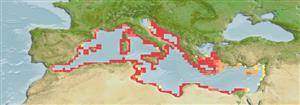>
Eupercaria/misc (Various families in series Eupercaria) >
Labridae (Wrasses)
Etymology: Centrolabrus: Greek, kentron = sting + Greek, labros = furious (Ref. 45335).
More on author: Risso.
Environment: milieu / climate zone / depth range / distribution range
Οικολογία
Θαλασσινό(ά) Υφαλόφιλο(α); εύρος βάθους 1 - 25 m (Ref. 4742). Subtropical; 46°N - 30°N, 6°W - 36°E
Mediterranean Sea: including the Sea of Marmara.
Μέγεθος / Βάρος / Age
Maturity: Lm ? range ? - ? cm
Max length : 14.0 cm TL αρσενικό/απροσδιόριστο; (Ref. 4742); common length : 11.0 cm TL αρσενικό/απροσδιόριστο; (Ref. 4742)
Adults are found in the littoral zone, in rocky areas and seagrass beds. Act as "cleaners". Feed on worms, small amphipods, copepods, bryozoans and hydrozoans (Ref. 4742). Males keep watch over Cystoseria-covered spawning territory though no nesting is done (Ref. 4742). Oviparous, distinct pairing during breeding (Ref. 205). Males build dish shaped nests and guard the eggs (Ref. 205).
Life cycle and mating behavior
Γεννητική Ωρίμανση | Αναπαραγωγή | Γεννοβολία | Αβγά | Γονιμότητα | Προνύμφες
Oviparous, distinct pairing during breeding (Ref. 205). Males build dish shaped nests and guard the eggs (Ref. 205).
Quignard, J.-P. and A. Pras, 1986. Labridae. p. 919-942. In P.J.P. Whitehead, M.-L. Bauchot, J.-C. Hureau, J. Nielsen and E. Tortonese (eds.) Fishes of the north-eastern Atlantic and the Mediterranean. UNESCO, Paris. Vol. 2. (Ref. 4742)
IUCN Red List Status (Ref. 130435)
Threat to humans
Harmless
Human uses
Περισσότερες πληροφορίες
ΑναφορέςΥδατοκαλλιέργειεςΠροφίλ υδατοκαλλιέργειαςΣτελέχοιΓενετικήElectrophoresesΚληρονομικότηταΑσθένειεςΜεταποίησηNutrientsMass conversion
Εργαλεία
Special reports
Download XML
Διαδικτυακές πηγές
Estimates based on models
Preferred temperature (Ref.
123201): 17.6 - 21.8, mean 19.3 °C (based on 481 cells).
Phylogenetic diversity index (Ref.
82804): PD
50 = 0.7500 [Uniqueness, from 0.5 = low to 2.0 = high].
Bayesian length-weight: a=0.01000 (0.00623 - 0.01606), b=3.04 (2.90 - 3.18), in cm total length, based on LWR estimates for this species & (Sub)family-body (Ref.
93245).
Τροφικό Επίπεδο (Ref.
69278): 3.2 ±0.1 se; based on diet studies.
Ελαστικότητα (Ref.
120179): Υψηλό, ελάχιστος χρόνος για διπλασιασμό πληθυσμού < 15 μήνες (Preliminary K or Fecundity.).
Fishing Vulnerability (Ref.
59153): Low vulnerability (10 of 100).
Nutrients (Ref.
124155): Calcium = 60.9 [26.9, 127.7] mg/100g; Iron = 0.761 [0.406, 1.555] mg/100g; Protein = 19.1 [16.2, 21.3] %; Omega3 = 0.23 [0.13, 0.41] g/100g; Selenium = 10.5 [5.0, 22.0] μg/100g; VitaminA = 85.7 [24.2, 370.8] μg/100g; Zinc = 1.24 [0.77, 2.20] mg/100g (wet weight);
